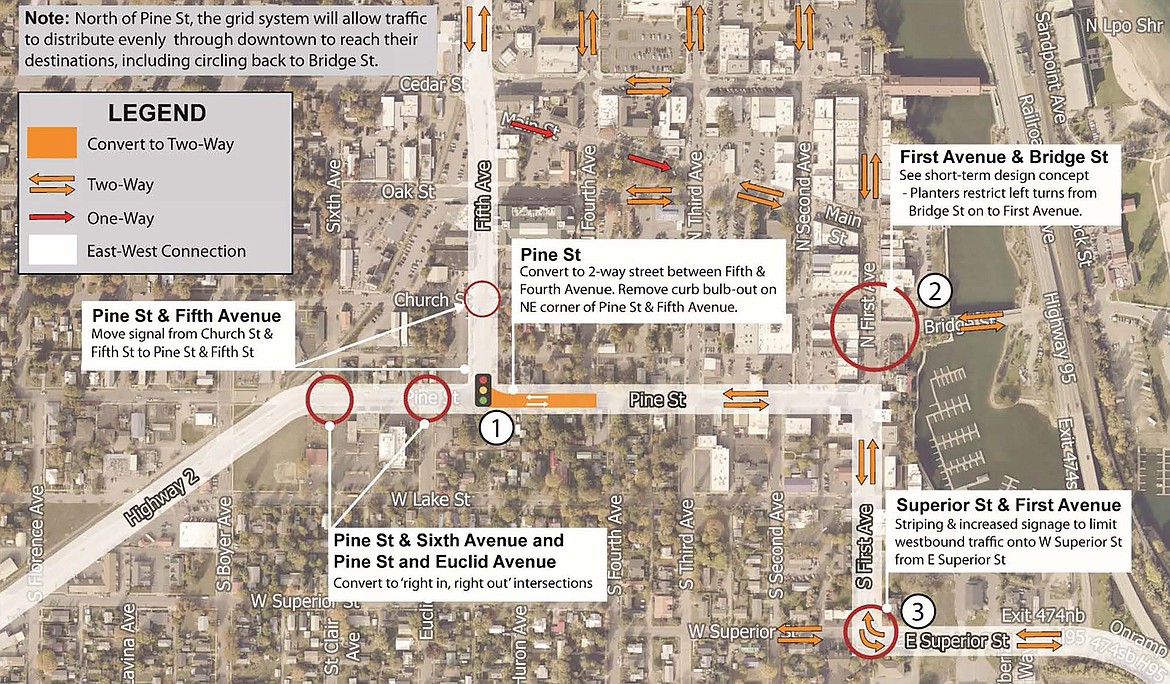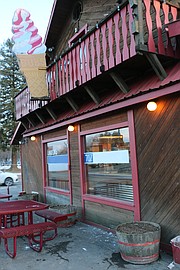City OKs purchase of Dub's site
SANDPOINT — After an extended debate over amendment of the city's multimodal plan, Sandpoint City Council got around to what prompted the discussion — purchase of the Dub's property.
After an hourlong discussion over how the purchase might impact the multimodal plan, the council voted 5-0 to approve the purchase of the property from owners Marty and Jeralyn Mire for $385,000. The site would then be leased back to the Mires for an initial period of two years, with the option to renew the $500-per-month lease in six-month increments. The couple plan to sublease the business to Ryan and Bethany Welsh, who would run Dub's with the intent to purchase it down the road, as well as relocate it when the time comes.
"Dub's is important to us," Jeralyn Mire told the council of their decision to sell and the condition for the lease back. "Our business has been our livelihood and our life for 35 years."
After their daughter and son-in-law, who had been running the restaurant for them, had an opportunity to pursue dream jobs outside of Dub's, the Mires decided to close the restaurant for the slow winter months while they pondered their next move.
They'd been through negotiations with the state over the Curve project, saying the process turned their lives upside down and threatened their livelihood with eminent domain a hanging threat over their heads.
"It was hard," Marty Mire said.
"It was a really rough time for us as business owners," added Jeralyn Mire.
They couldn't, with good conscience, put anyone else in that same position and decided to approach both the city and the state about their plans to sell the property. However, they told the city it was critical to them that the business be allowed to continue, giving Dub's the ability to continue.
So when the Welshes approached them about continuing Dub's, they wanted to be able to give them that chance, that certainty that they didn't have for those years.
"What's important to us is not only a fair purchase price, we feel it's reasonable, it is not padding anyone's retirement," Jeralyn Mire said. "But even more critical is to make sure that there's the ability for a young couple to start their life and be able to lease the business from us, we will need to sublease the property back so that they can start their new Dub's and take it into the next 35 years, we hope.
"I think those are really the things that we have looked at to do the best that we can for our community, and we would much prefer the city to be in control of this property."
Funds for the purchase would come from carryover from capital projects and existing available monies not yet budgeted for this fiscal year.
The city doesn't have any immediate plans and is onboard with leasing the site back to the Mires so that they can sublease the business to the Welshes.
"We're not tearing down a business that could be viable," City Administrator Jennifer Stapleton said. "Somebody wants to operate in the short-term, but ultimately then creating predictability for a business owner that a long-term, viable location, while saving taxpayers what would be future costs for a more expensive purchase of this property."
While they support the city's purchase of the property, several council members as well as several residents called for a pause on amending the multimodal master plan.
"It seems somewhat inappropriate to be amending a community plan that's over 100 pages long, has a lot of good things in it, without getting some public input on it," said Steve Holt, who served on the Bonner County Association Traffic Team and served on the Highway 2/200 corridor committee.
The multimodal plan works to balance the needs of pedestrians, bicyclists and drivers while keeping the inherent character of Sandpoint intact, Amanda Wilson, director of Infrastructure & Development for Sandpoint, said.
Conversations about what to do when the need for improvements in the Highway 2/200 corridor hit the tipping point have been going on for decades, Wilson said.
Before the current street pattern was adopted, the transportation department had approved the Curve design to move east/west traffic through Sandpoint. However, plans to improve safety and get ahead of projected increased traffic volumes date back to 2000 with the city's Downtown Economic Report and the city taking over responsibility for its streets. Adoption of the city's Comprehensive Plan took place in 2009, as well as adoption of the Urban Transportation Plan that same year.
An agreement to transfer ownership of the streets was hammered out in 2015 with the reversion of the downtown streets to two-way traffic under the city's control completed in 2017, Wilson said.
Downtown revitalization efforts were completed between 2018 and 2021, followed by adoption of the city's multimodal transportation master plan in 2021. At roughly the same time, ITD launched a study of U.S. 2 from Spokane to Sandpoint, in 2020.
In creating the multimodal plan, Wilson said a key component was protecting the businesses. That meant the city was limited in how it could address pedestrian safety issues and correcting a skewed intersection connecting the north and south portions of Boyer Avenue.
However, purchase of the Dub's property opens the door to more design options — giving the city a chance to address shortcomings in the existing document.
When the city asked ITD to consider alternatives to the Curve project, Wilson said the two sides negotiated an agreement on the transfer of the streets back to the city's control. As part of that, ITD agreed to pause the Curve project and implement the city's preferred alternative. However, the city agreed to accept a lower standard of service on its streets — with the understanding that once service went below a D level, improvement efforts in the corridor would be resumed.
"Ultimately, we signed an agreement, a cooperative agreement with ITD stating that … when the system begins to not function as they define functioning, that we would accept those impacts to our system and that they would move forward with the project," Wilson said.
She told the council she wanted them to understand that while the Curve project was paused, it didn't go away and remains the only approved design for traffic improvements in the corridor.
"So I bring up this cooperative agreement because I think that sometimes it is a little bit lost that the Curve went away. It did get paused," she said. "However, we signed an agreement that says, when their system is functioning at an unacceptable level, meaning when the volume gets to the point that their systems are no longer functioning to their standards, that they would implement a project."
While one street may function at a D, another may be functioning at an A, averaging out to a B. Removing access from some streets, pacing of street lights and other options can be used to mitigate failing levels of service before a construction project is implemented.
A point of frustration for several council members is the car-centric nature of how level of service is defined — and how that impacts the approach taken by state and federal agencies.
"We promote Sandpoint as a pedestrian town, a place to be, but we are stuck with the state regulations that put a priority on a car specifically, not on a human being, but on a car," Councilwoman Deb Ruele said. "So as a council person sitting up here fighting the state, it's a frustration that maybe we should flip-flop the system and prioritize what we want."
Wilson and Preston Stinger of Fehr & Peers, who has worked with the city on its multimodal plan, told the council they understood the frustrations, but noted ITD's agreement with the city allows for a lower level of service than normal.
There is a recognition, Wilson added, that the city has broader priorities that are reflected in its multimodal plan. During numerous meetings related to the multimodal plan with up to a "dozen engineers in a room at a time," Wilson told the council that ITD officials are open to plans as long as the data is there.
"My point here is as long as the data works, ITD is usually onboard," she said, adding that she didn't think the agency has "an interest of bucking the tide on this one."
Under the proposed concept outlined in the multimodal plan, Pine Street would remain a two-way street, with the signal moving from Fifth and Church back to Fifth and Pine. Northbound traffic would be routed onto Fifth, while southbound traffic would be routed onto a new roadway paralleling the current Sandpoint-to-Dover walking/biking path — much like the "Curve" design.
The design drew heavy criticism in the mid-2010s — both for the proposed destruction of up to four businesses, including Dub's, along with an expanded traffic corridor with the potential for a four- to five-lane roadway through the community.
Purchase of the property gives the city a unique opportunity not only a chance to fix a problematic intersection but also to improve connectivity in south Sandpoint and lets businesses in that corridor know exactly how they would be impacted.
"We committed to making sure that the business itself wasn't impacted, as far as the property. We committed that we would find ways to provide driveway approaches so that people could still get in and out of the business, that they would still have a route to it," Wilson said. "But the overall through-traffic of South Sandpoint using South Boyer is substantially limited in our adopted plan because we favored retaining businesses."
While the purchase of the Dub's property allows the city to address shortcomings in the multimodal plan that weren't possible when the site wasn't in play, council members said they want to get it right, and supported tabling the changes.
"From what I see the multimodal plan, as it sits today, presents a four- to five-lane proposal to the ITD," Welker said. "And if we're going into negotiations, I don't view that as a strong negotiating position if our community's overwhelming desire is for traffic-calming measures, possibly a three-lane solution."
Hitting pause allows the city to look at additional changes beyond the realignment of Boyer, that purchase of the Dub's property addresses, he added.
"We don't want to create a situation where we're diverting frustrated Highway 2 passersby onto residential streets where kids are playing," Welker said. "I also view this as a planning document, representing the values and the desires of the people of Sandpoint. The idea that we are presenting to the ITD this document is almost like their dream come true, with a four- and five-lane highway right through town."
If the matter is to be a negotiation then the city needs to enter that discussion with a document that reflects the wishes of those who live in Sandpoint.
"I would urge us all to consider amending or further amending our multimodal transportation plan to more accurately reflect what I believe the people of Sandpoint desire, which is less volume and not a doubling of a more than 100% increase in volume," he added.





